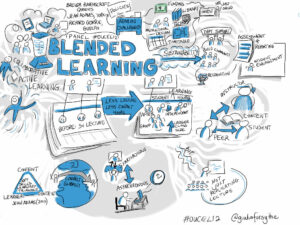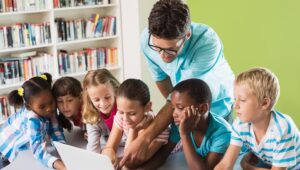My name is Navneet kaur. I am from India, and this is my second course in the Master of Education program. In today’s fast-paced world, Technology plays an essential role in everyone’s life. Technology like computers, laptops, tablets, and smartphones is becoming more and more integral to our daily lives. Technology’s integration into education is inevitable because technology has always been a crucial component of sustaining and developing society. Online education technologies make access to the most recent and superior information possible. Textbooks and other printed materials can soon contain out-of-date content, and updating them might take a long time. I believe that when people use online resources, educational materials are always up-to-date and relevant, and they may be seamlessly incorporated into the learning process. Technology can provide students with access to large amounts of online resources and information. They can conduct independent studies as a result of this, which motivates and supports them. Through the use of instructional films and audio streams, technology can help make learning simpler by making complex concepts easier to understand for a variety of learning styles. Technology helps to keep pupils’ attention, which improves their ability to learn. By moving from a traditional classroom environment to an online learning platform, educators are able to use more interactive tools and approaches that engage students. The transition from static learning materials to more dynamic interactive media content is made possible by technology. When students are actively engaged in academic activities while passively listening to a teacher and reading textbooks, they frequently learn more quickly and effectively. Technology in education is a powerful tool that can enrich and improve the education process for both teachers and students. The use of technology in education has transformed learning and the way that people retain information. It has become a fundamental part of learning, and its development and application should be embraced by all educators in a way that best suits them and their students.

2019 saw the beginning of my use of a virtual learning environment due to pandemic school closings. Due to the pandemic, traditional in-person education has given way to hybrid or distant learning methods. Most of the teachers in my school were getting used to using computers, learning how to best transfer the benefits of in-person training to the online environment, and figuring out how to use technology-supported instruction to enhance student learning. In my classroom, this educational strategy was employed. When I switched to remote study in 2019, I had to make the most of hybrid learning in a completely virtual environment. I had already researched the well-liked classroom model, which combines independent viewing of educational films at home with class time devoted to completing tasks. As I transitioned to remote learning, I worked to replicate the advantages of traditional in-person learning by using live, virtual small-group classes that gave students the opportunity to ask clarifying questions in real-time and to provide peer-to-peer learning opportunities as well as crucial social interactions. I also created activities that promoted participation and engagement among young children in order to teach them. I used many strategies, including online discussion forums, virtual breakout rooms, interactive quizzes, multimedia presentations, and collaborative projects. These strategies helped provide opportunities for students to talk to one another, exchange ideas, and work together on assignments to promote a sense of community. I also used the strategy of the short student presentation, in which I asked the students to make a presentation on the topic of their interest. Short presentations provide an opportunity for students to engage in peer instruction. This type of activity invites students to synthesize and communicate their knowledge In addition to learning from their peers, this enables students to relate the course material to their own interests and personal experiences. Before beginning the actual learning, I tried to show online sources of knowledge and learning. To develop dynamic, inclusive, and personalized hybrid learning experiences, innovative teaching techniques must be combined with new technologies and collaboration tools. Digital tools are used to promote and provide opportunities for teachers to improve their teaching methods. For example, various activities in the learning process could increase motivation and engagement among students. Nevertheless, one of the biggest obstacles to blended learning is teachers’ lack of digital literacy. Teachers must become digitally literate in order to teach a digital curriculum, and students must comprehend how to use technology effectively. In order to improve teachers’ skills and effectively implement blended learning, I think boosting teacher empowerment and professional development funds is essential. In addition to this, Technical and network problems made it difficult to teach and learn effectively. Teachers encountered a variety of technological hurdles, including erratic internet connections, restricted access to hardware and software, and challenges diagnosing technical problems for both themselves and their students.

We rely on technology more than ever before as a result of the COVID-19 pandemic. I still remember the day I started working at D.R.S. Convent School in 2019 after receiving my bachelor’s in teaching. Schools were closed because of COVID-19, and I had been a science teacher. Learn how things function in reality by studying science. I was eager to instruct students in a lab setting because it is a subject that is also highly practical. Teaching students in grades 6 through 10 was a remarkable experience for me, but after COVID-19, everything was different. I started using technology regularly in my classrooms to teach the students. When I initially started teaching online, I fully embraced Google Classroom. At first, I faced trouble using technology, but when I started using it, I learned so many things from it, and after some time, it was quite easy for me to teach students with the help of technology. Using technology has made teaching and learning more enjoyable. I still remember that time when my colleague assisted me in creating a lesson plan and uncovering different methods of instructing students, and thanks to an online and connected design, interactive displays assisted me in tracking student performance and attendance, whether in class or from home. As time goes on and conditions necessitate new modes of instruction, blended and hybrid learning become more common and useful. However, as the value of new educational technology for blended classrooms increases, obstacles also do. The metaphorical digital barrier between students from various backgrounds and circumstances can be addressed by using tools like interactive screens as focus areas for hybrid learning. While online and blended learning offers several advantages, they also come with their fair share of challenges. The digital gap is one of the major challenges I’ve encountered. It is inevitable that not all students and even teachers will have the same amount of access to technology due to economic, social, and personal factors. Families with multiple children may only have one laptop, which makes managing remote learning challenging. A lot of students don’t have personal smart devices, so when they go for in-person teaching, bringing their own devices isn’t an option for them. However, internet access is far from universal in terms of speed and reliability across all households worldwide. Due to the inability of educators to directly address the fundamental causes, these availability gaps provide enormous difficulties when attempting hybrid learning that depends on individual digital devices and ongoing high-speed internet access. The most frequently cited in-class blended learning challenge for learners identified by me was a lack of basic computer and digital skills including being able to navigate different platforms and devices, keyboarding, using a password, etc. Other typical problems were being easily distracted, having poor desire and independence, being afraid of and uncomfortable with technology, and having difficulty understanding others’ languages. Concerning the lack of fundamental digital knowledge and abilities in particular, as well as affective problems and distractions, respondents’ expectations for learners engaging in blended learning outside of the classroom overlapped with those observed within. The two most common issues that I noticed were a lack of or subpar internet service and inadequate or obsolete gear. Poor motivation or self-direction, a lack of time, and poor time management skills were additional difficulties specific to home-based blended learning activities.

Allowing every student to fully engage in their studies and take an active role in their education is the ultimate goal of incorporating technology in the classroom, regardless of their abilities, talents, or requirements. Technology creates an inclusive work environment, increases engagement, provides seamless experiences, promotes transparency, and ultimately saves both time and money. Students will gain self-confidence and empowerment. Teachers have access to a wide variety of instructional resources and materials because of technology. They have access to open educational resources, digital textbooks, online libraries, and educational websites, which broadens their range of possible lessons and improves the caliber of their instruction. Students are provided with new abilities as digital learners with encouraging direction, well-defined objectives, and careful training on how to utilize technology appropriately and effectively. All of these skills assist students in improving their academic performance and achieving success in their professional lives.
